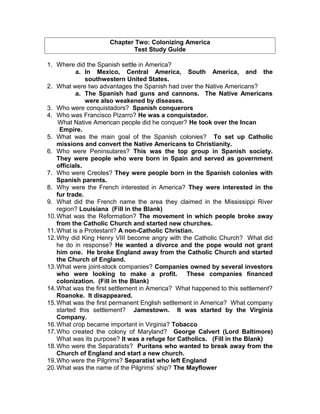
Chapter Two study guide
- 1. Chapter Two: Colonizing America Test Study Guide 1. Where did the Spanish settle in America? a. In Mexico, Central America, South America, and the southwestern United States. 2. What were two advantages the Spanish had over the Native Americans? a. The Spanish had guns and cannons. The Native Americans were also weakened by diseases. 3. Who were conquistadors? Spanish conquerors 4. Who was Francisco Pizarro? He was a conquistador. What Native American people did he conquer? He took over the Incan Empire. 5. What was the main goal of the Spanish colonies? To set up Catholic missions and convert the Native Americans to Christianity. 6. Who were Peninsulares? This was the top group in Spanish society. They were people who were born in Spain and served as government officials. 7. Who were Creoles? They were people born in the Spanish colonies with Spanish parents. 8. Why were the French interested in America? They were interested in the fur trade. 9. What did the French name the area they claimed in the Mississippi River region? Louisiana (Fill in the Blank) 10.What was the Reformation? The movement in which people broke away from the Catholic Church and started new churches. 11.What is a Protestant? A non-Catholic Christian. 12.Why did King Henry VIII become angry with the Catholic Church? What did he do in response? He wanted a divorce and the pope would not grant him one. He broke England away from the Catholic Church and started the Church of England. 13.What were joint-stock companies? Companies owned by several investors who were looking to make a profit. These companies financed colonization. (Fill in the Blank) 14.What was the first settlement in America? What happened to this settlement? Roanoke. It disappeared. 15.What was the first permanent English settlement in America? What company started this settlement? Jamestown. It was started by the Virginia Company. 16.What crop became important in Virginia? Tobacco 17.Who created the colony of Maryland? George Calvert (Lord Baltimore) What was its purpose? It was a refuge for Catholics. (Fill in the Blank) 18.Who were the Separatists? Puritans who wanted to break away from the Church of England and start a new church. 19.Who were the Pilgrims? Separatist who left England 20.What was the name of the Pilgrims’ ship? The Mayflower
- 2. 21.Who was Squanto? Native American who helped the Pilgrims survive. 22.What is the Thanksgiving Holiday based upon? The feast shared between the Pilgrims and the Native Americans. 23.Who was John Winthrop? Owner of the Massachusetts Bay Company and he started the Massachusetts colony. 24.List 2 characteristics of the Massachusetts Bay colony. 1. No separation between church and state. 2. Other religions were not accepted. 25.What settlement did Roger Williams start? Providence 26.What types of freedoms were allowed in Rhode Island? Freedom of religion 27.Who started the colony of Connecticut? Why did he do this? Thomas Hooker. He wanted more farmland and also did not like the government in Massachusetts. 28.Who was John Mason? He started New Hampshire 29.What was the name of their major settlement? New Amsterdam 30.Who were Sir George Carteret and Lord John Berkley? They started New Jersey 31.Who was William Penn? He started Pennsylvania and Delaware 32.Who were the Quakers? A religious group that believed people should be guided by their “inner light” not by ministers or the church. 33.What was the major settlement in South Carolina? Charles Town 34.What crop became important in South Carolina? Rice 35.What characteristics of the English colonies would lead to revolution in 1776? Self government and religious freedom Part Two: Identification: The following term will appear on the test as Identification. Write complete sentences on the term selected. House of Burgesses – It was an elected assembly that proposed laws. It was the first representative assembly in America.